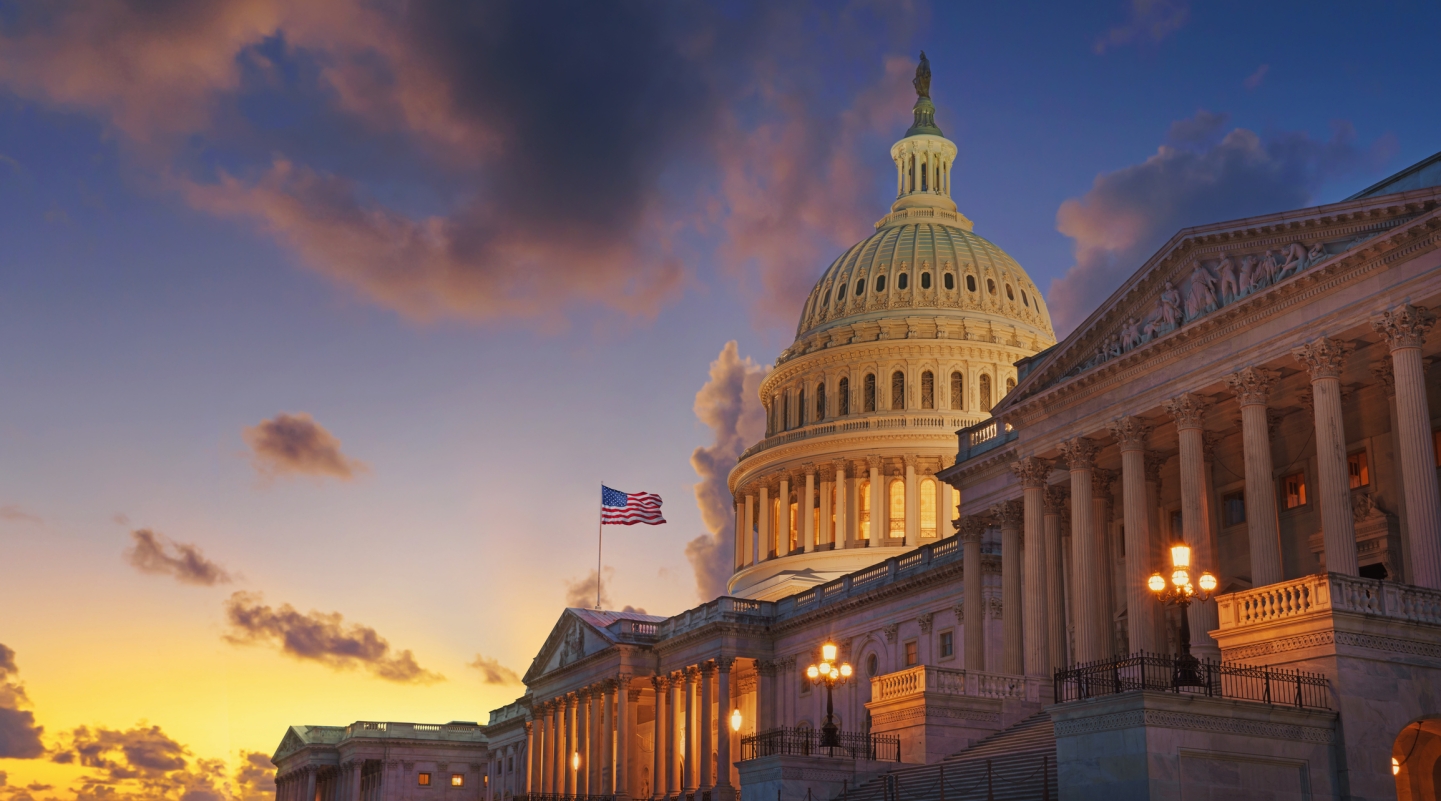U.S. Elections Analysis 2024: Key Outcomes & Insights for Counties
Upcoming Events
Related News
Jump to Section
- County Connections: Former County Officials in the 119th Congress
- Priorities for the Remainder of the 118th Congress
- Presidential Election
- U.S. Senate Elections
- U.S. House of Representatives Elections
- Gubernatorial Elections
- State Legislature Races
- State Ballot Initiatives
- Looking ahead: Timeline of the 118th and 119th Congresses
Last updated Nov. 19, 2024.
Executive Summary
The 2024 elections resulted in a significant shift in federal leadership, with key implications for county governments across the United States. The 2024 election cycle follows a recent pattern of change, with 11 out of the past 13 elections (exceptions in 2004 and 2012) resulting in a shift in control of the White House, House or Senate.
Counties play a vital role in the administration and oversight of elections across the country. This includes management and coordination of voter registration, poll workers, polling places, and the casting and tallying of votes. During each election cycle, counties oversee over 100,000 polling places and manage over 630,000 poll workers. Thank you to county government officials and volunteers for playing a crucial role in upholding our democratic system.
Presidential Election
President-elect Donald Trump has been declared the unofficial winner of the 2024 presidential election. More than 90 percent of counties shifted in favor of President-elect Trump in the 2024 presidential election, according to a preliminary analysis by the New York Times, improving his vote margin from 2020 in more than 2,300 counties. President-elect Donald Trump and Vice-President elect J.D. Vance will assume their respective roles on January 21, 2025.
Congress
U.S. Senate Republicans have taken majority control with 53 seats in the Senate, flipping four seats, with key pickups in Montana, Ohio, Pennsylvania and West Virginia. Democrats retained contentious seats in Michigan, Nevada, Wisconsin and Arizona. Republicans retained narrow control of the House, having met the 218-seat threshold needed for chamber control. This solidifies a Republican trifecta with control over the Presidency, House and Senate.
Governorships
There were eleven governors seats up for election in 2024. All three incumbents, Greg Gianforte (R-Mont.), Spencer Cox (R- Utah), and Phil Scott (R-Vt.) retained office. No governor seats were flipped, maintaining the GOP control of 27 seats to the Democrats’ 23.
State Legislatures
Eighty-five of the country's 99 state legislative chambers held regularly scheduled elections in 2024, representing 5,807 of the country's 7,386 state legislative seats (79 percent). The GOP made slight gains in control of state legislatures, flipping the Michigan House and attaining a tie in the Minnesota House. Democrats lost “trifecta” control, or control of both state chambers and the governorship, in two states. There are now 38 trifectas across the U.S., down from 40.
Key Takeaways
- Eleven of the past thirteen federal elections (with exceptions in 2004 and 2012) have resulted in a shift in control of the White House, House, and/or Senate.
- The 2024 cycle had the second highest voter turnout (63.3 percent) since 1960, only topped by the 2020 election (66.7 percent).
- President-elect Trump is the first GOP candidate to win the popular vote since 2004, sweeping all seven 'toss up' states including six won by President Joe Biden.
- Following the 2024 election, there are only three split state delegations in the U.S. Senate, in Wisconsin, Pennsylvania and Maine.
- For the first time since 1795, the U.S. House has seen three consecutive Congresses with a single digit party division.
- Trifectas (where one party controls both houses of the state legislature as well as the governorship) still dominate the national landscape.
Former County Officials Elected During November Elections
Of the 69 former county officials in the 119th Congress, five of them are freshman members.
Come January 20, 2025, President-elect Donald Trump will be sworn in as the 47th President of the United States. On January 3, 2025, new members of Congress will be sworn and being the 119th Congress. There are 69 former county officials in the 119th Congress, with a wide variety of positions and experiences. Current county elected officials with connections to these lawmakers should reach out and utilize the shared understanding of the importance of local governments to foster greater collaboration.
Of the 69 former county officials in the 119th Congress, five of them are freshman members. They are Senator-elect Angela Alsobrooks and Representatives-elect George Latimer, John Olszewski and Michael Baumgartner. Senator-elect Jim Banks is a freshman in the Senate, however, previously served three terms in the House.
County Officials in the U.S. Senate
Note: Names in bold indicate first-term senators.
County Officials in the U.S. House of Representatives
Note: Names in bold indicate first-term representatives.
County Priorities for the Remainder of the 118th Congress
After the conclusion of the November 5 elections, the current Congress has approximately 24 session days in the Senate and 20 session days in the House before the transition to the 119th Congress. During the upcoming lame duck session, Congress will face multiple pieces of legislation that must be addressed quickly. Most notably, Congress must confront the looming government funding deadline of December 20, 2024, and the 2024 Farm Bill.
The Farm Bill supports vital investments in infrastructure, economic development, workforce training, nutrition, and conservation in underserved rural communities. Counties urge a long-term reauthorization of the Farm Bill before the 2018 version expires at the end of 2024, emphasizing the importance of securing key provisions like the Rural Partnership and Prosperity Act (S. 3309/H.R. 7444), the Expanding Childcare in Rural America Act (S. 1867/H.R. 3992), and the Secure Rural Schools Reauthorization Act (S. 2581/H.R. 5030). These measures would enhance rural development, childcare access, and extend the SRS program to 2026, and counties will continue working with federal partners to pass a bipartisan Farm Bill that includes these priorities.
Although Medicaid reimbursements have historically fallen below costs, they remain crucial for county-supported hospitals. To offset these revenue gaps, the federal government provides Medicaid Disproportionate Share Hospital (DSH) payments to hospitals that serve high numbers of Medicaid patients. The Affordable Care Act (ACA) aimed to reduce the uninsured population and, consequently, the need for Medicaid DSH payments. Thus, it directed reductions in DSH allotments, initially set to decrease incrementally from $500 million in FY2014 to $5.6 billion in FY2019. However, these reductions have been delayed and modified by over a dozen laws, most recently under the Consolidated Appropriations Act, 2024. Under current law, DSH reductions are scheduled from FY2025 to FY2027. Counties are urging Congress to repeal or delay these reductions, which are set to begin January 1, 2025, so that local hospitals have the revenue streams needed to keep their doors open.
The Affordable Connectivity Program (ACP), launched in 2021 under the Bipartisan Infrastructure Law, provided affordable internet access to 23 million households by offering up to $30 per month for service and a $100 discount for devices. The program helped bridge the digital divide by enabling access to virtual education, telehealth, and remote work. However, funding for the ACP ended in May 2024, and counties urge Congress to support passage of the Affordable Connectivity Program Extension Act of 2024 (H.R. 6929/S.3565) to allocate additional funds to restore these vital services.
The Payment in Lieu of Taxes (PILT) and Secure Rural Schools (SRS) programs provide essential funding to counties with significant federal land and forests, compensating them for the inability to collect taxes on these lands while still providing critical services like infrastructure maintenance, law enforcement, and wildfire response. Counties urge Congress to fully fund the PILT program and enact a long-term solution for SRS, which expired in late 2023, causing an 80 percent reduction in funding for affected counties. Furthermore, counties also support the swift passage of the Secure Rural Schools Reauthorization Act of 2023 (S. 2581/H.R. 5030) to ensure continued revenue-sharing payments to forested counties.
Counties rely on federal funding determined through the annual appropriations process to provide vital services to our residents. This includes funding for the Affordable Connectivity Program, full funding for the Weatherization Assistance Program (WAP), increased funding for Help America Vote Act (HAVA) grants for election administration, and more. As such, counties urge Congress to reach an agreement on long term appropriations to provide counties funding certainty when planning budgets and preparing to deliver essential services.
The U.S. Economic Development Administration (EDA) is the only federal agency with a mission focused solely on private sector job creation in distressed areas. EDA has achieved an impressive track record of making strategic investments and building partnerships that help regions and communities respond to shifts in international markets, address severe unemployment challenges and recover from plant closures, major natural disasters and other chronic, sudden or severe economic hardships. Going into the November elections, an amendment to reauthorize the EDA was adopted by the U.S. Senate Armed Services Committee (SASC) as part of the National Defense Authorization Act (NDAA), which will now be negotiated between the House and Senate SASC leadership for its official inclusion. Counties urge Congress to include this amendment and reauthorize the EDA.
Title IV-B of the Social Security Act authorizes formula grants that provide flexible funding to enhance the wellbeing of children and families through prevention services, child protection, family preservation, child welfare workforce training, reunification services and adoption promotion and support. Counties urge Congress to pass the bipartisan Protecting America's Children by Strengthening Families Act (H.R. 9076), a comprehensive package that will modernize and strengthen child welfare and child support programs through new resources to support child welfare caseworkers, new flexibility to serve families experiencing poverty, and ensure continuity of operations for county child support enforcement agencies.
In 2023, over 800 counties experienced at least one federally declared disaster and the nation set a record for most billion-dollar disasters. Recently, Hurricanes Helene and Milton have devasted the southeast region of the country, causing tragic loss of life and widespread destruction to locally owned infrastructure and homes. With communities coast to coast in the midst of recovery efforts, counties urge Congress to immediately pass a disaster supplemental package that includes funding for programs such as the Small Business Administration’s Disaster Loan Program, U.S. Federal Emergency Management Agency’s Disaster Relief Fund and the U.S. Department of Housing and Urban Development’s Community Development Block Grant – Disaster Recovery Program. All these programs provide critical resources to impacted areas, without which we would not be able to meet the recovery needs of our communities and residents.
Presidential Race
Notable shifts include counties in New York, South Carolina, Georgia. Major shifts include urban counties in Florida and along the Rio Grande.
Swing States All Swing Right
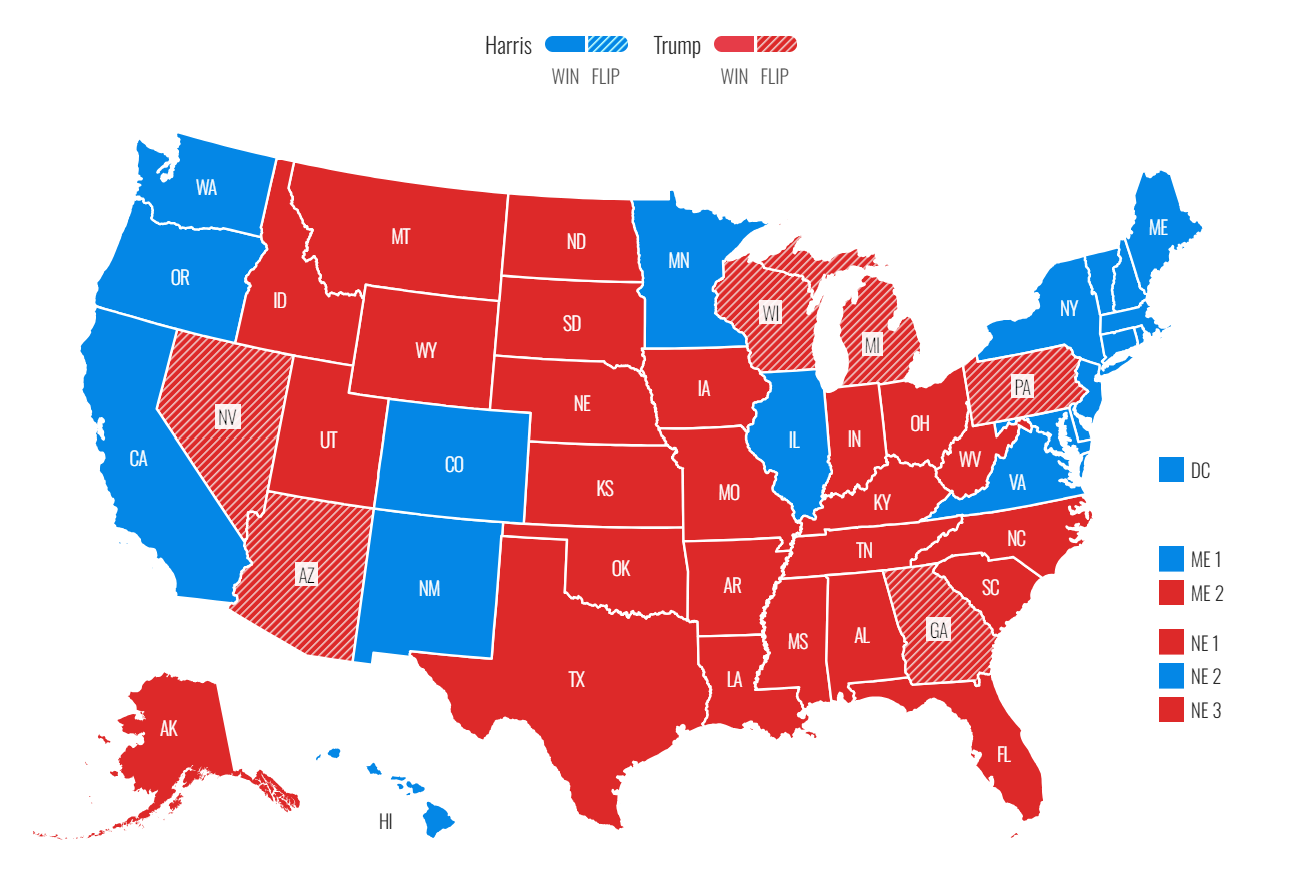
U.S. Senate Races
Republicans regain control of the Senate
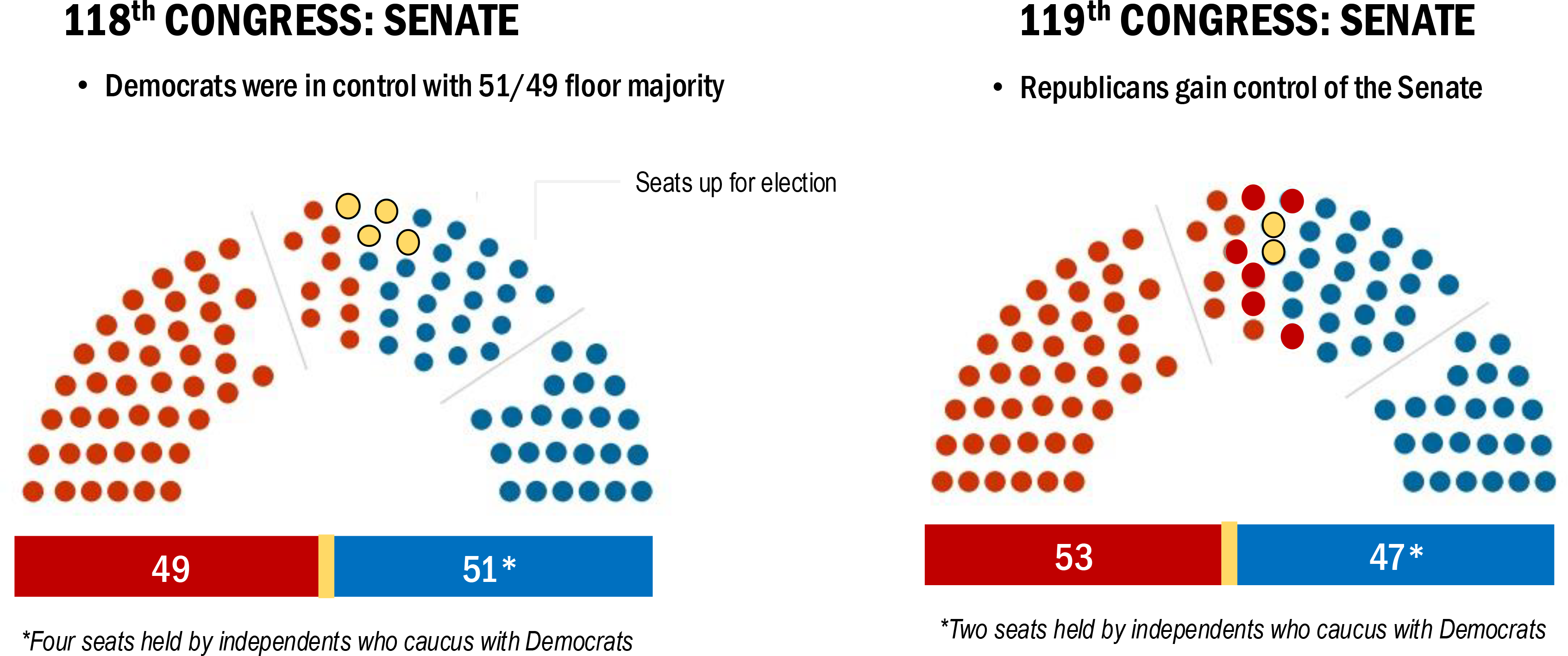
U.S. Senate Results
Democratic Gain
Democratic Hold
Republic Gain
Republican Hold
Bold indicates race winners.
* Asterisks indicate incumbents.
U.S. House of Representative Races
Republicans retain control of the House
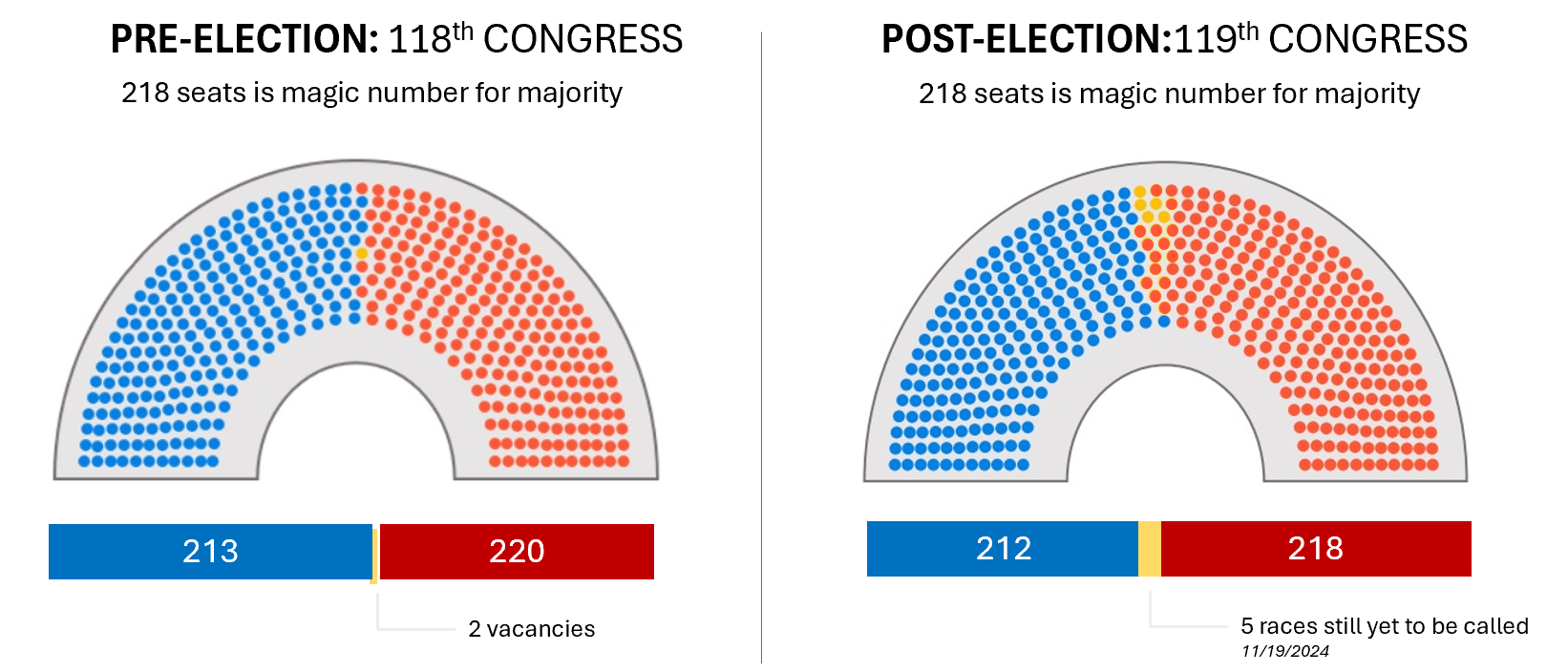
U.S. House Results
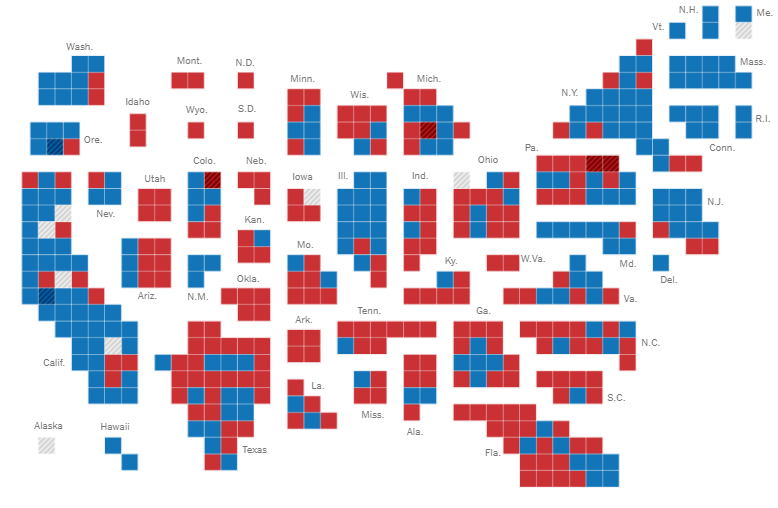
Source: New York Times
Gubernatorial Results
Republicans maintain a majority of governorships
Democratic Hold
Republican Hold
Bold indicates race winners.
* Asterisks indicate incumbents.
Orange indicates former county officials, and italics indicate former county officials newly elected to governorships.
Heading into the 2024 election, 11 governor seats were up for reelection. Republicans controlled a majority of these offices, holding eight approaching election day. Three incumbents ran successfully for reelection and no seats were flipped. This maintains the GOP control of 27 governorships to the Democrats’ 23.
State Legislature Results
Republicans maintain dominance of state legislatures
Heading into the 2024 elections, control of 85 state chambers were up for election. Coming into November 5, Republicans controlled 50 legislatures and Democrats controlled 33. Two legislatures up for election are organized under a power sharing structure. Additionally, only one state legislature had split control coming into the election.
After the 2024 election, there is now projected to be trifecta control in 38 states (-2), with 23 Republican-controlled states, 15 (-2) Democratic-controlled states and 12 (+3) with divided governments. Tracking legislative control at all levels of government is key to close coordination and intergovernmental cooperation.
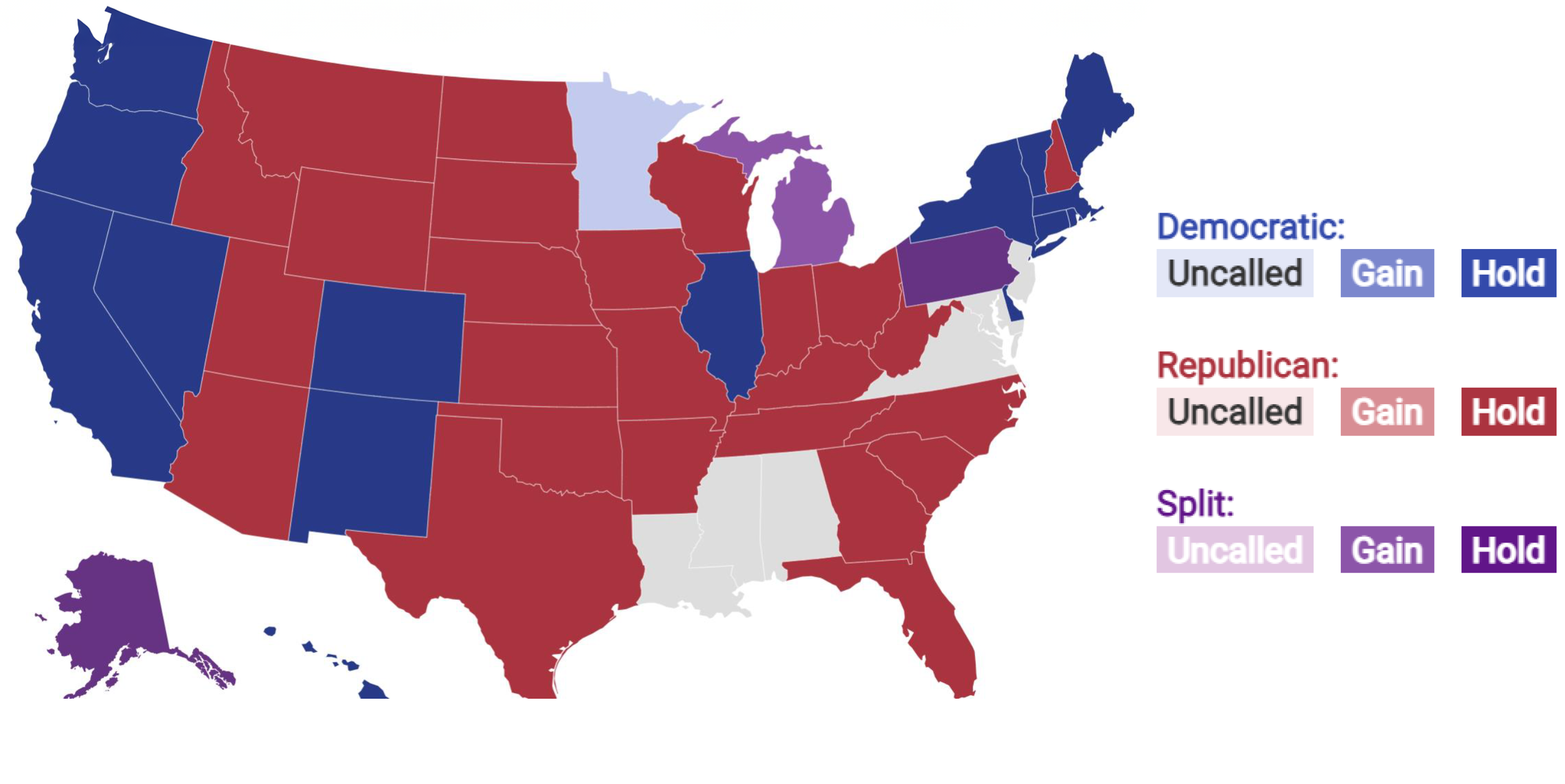
State Ballot Initiatives Results
Many states held important votes on ballot initiatives relevant to counties. These initiatives impact county finances, required operations and organizational structure.
Looking Ahead
Timeline of 118th and 119th Congresses
2024
- Lame duck session: November 12, 2024- January 21, 2025
- Senate reconvenes: November 12, 2024
- House reconvenes: November 12, 2024
- Organizing conference meetings for the 119th Congress: November 13, 2024- November 15, 2024
- Congress recesses for Thanksgiving: November 25- November 29, 2024
- Senate back in session: December 2, 2024
- House back in session: December 3, 2024
- Continuing Resolution expires: December 20, 2024
- 118th Congress ends: December 20, 2024
2025
- 119th Congress swearing in: January 3, 2025
- 47th President of the United States takes office: January 20, 2025
- State of the Union: Late January
- Congressional deadline for White House FY 2026 budget request: February 3, 2025
- FY 2026 appropriations deadlines vary throughout Congress: March- April
- FY 2025 ends: September 30, 2025

